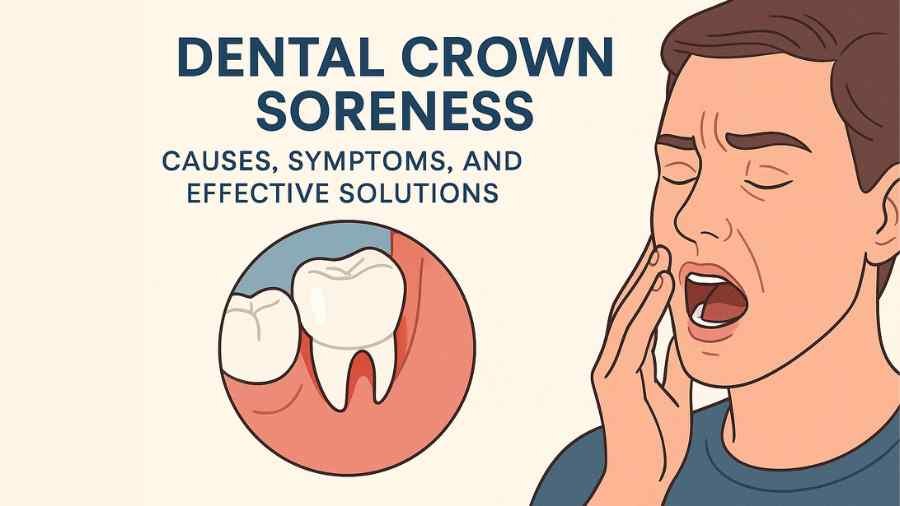Dental Crown Soreness: Causes, Symptoms, and Effective Solutions

Dental treatments are designed to improve both function and aesthetics, yet sometimes they can leave patients with unexpected discomfort. One of the most common concerns after restorative dental work is dental crown soreness. While crowns are intended to restore strength, shape, and appearance to damaged teeth, the period following placement may bring sensitivity or pain that causes patients to worry. Understanding why this occurs, what it feels like, and how it can be treated is essential for peace of mind and long-term oral health.
What Is Dental Crown Soreness?
Dental crown soreness refers to discomfort, tenderness, or sensitivity experienced in the tooth, gum, or surrounding area after a crown has been placed. Patients often describe it as a dull ache, sharp pain when biting, or sensitivity to temperature changes. In many cases, the soreness is temporary, linked to the procedure itself and the natural adjustment period as the tooth adapts to its new covering. However, there are times when soreness signals an underlying issue that requires professional intervention.
Crowns are used to protect teeth that are cracked, weakened, or heavily filled. They are also fitted after root canal treatment or when a tooth is misshapen. Because the procedure involves reshaping the tooth, placing a temporary covering, and cementing a permanent crown, the tooth and surrounding tissues may react with irritation.
Common Causes of Dental Crown Soreness
Several factors may contribute to soreness following crown placement. Recognising the source of discomfort is the first step to finding relief.
1. Procedure-Related Trauma
The crown preparation process involves filing down the tooth structure and sometimes disturbing the pulp or nerve. This mechanical irritation may leave the tooth sensitive for days or weeks afterwards. The discomfort is typically mild and diminishes over time as the tooth heals.
2. Improper Bite Alignment
If the crown is slightly higher or lower than neighbouring teeth, it can cause an uneven bite. Each time you chew, the crown may hit first, placing additional pressure on the tooth and surrounding tissues. This creates persistent soreness and sometimes sharp pain when biting down. Bite adjustments are relatively simple for a dentist to perform and can resolve the problem almost immediately.
3. Nerve Inflammation or Infection
In some cases, the tooth beneath the crown may still contain a live nerve. If this nerve becomes inflamed or infected, pain can result even after the crown has been fitted. Patients might experience lingering sensitivity to hot or cold, or a throbbing ache. If left untreated, an infection may spread and require root canal therapy.
4. Decay Beneath the Crown
Although crowns are designed to seal and protect, bacteria can occasionally creep under the margin, particularly if oral hygiene is not maintained. Decay beneath a crown often presents as ongoing soreness, sensitivity, or swelling. Treatment usually involves removing the crown, cleaning the cavity, and either repairing or replacing the restoration.
5. Gum Irritation
The gum tissue around a newly crowned tooth may become inflamed due to the placement process or cement residue. Soreness of this nature is usually localised to the gum and can be soothed with warm saltwater rinses or improved brushing and flossing techniques.
6. Bruxism (Teeth Grinding and Clenching)
Patients who grind their teeth at night or clench during the day often place excessive stress on their crowns. This habit can lead to soreness, fracture of the porcelain surface, or even loosening of the crown. Wearing a custom mouth guard can reduce pressure and protect both crowns and natural teeth.
7. Loose or Damaged Crown
If a crown becomes cracked or dislodged, movement can irritate both the tooth and surrounding gums. This may cause discomfort that worsens over time. A loose crown should always be examined by a dentist, as it risks further decay or damage to the underlying tooth.
Symptoms Associated with Dental Crown Soreness
Understanding the range of symptoms helps patients distinguish between normal healing and conditions requiring further treatment. Common experiences include:
Mild sensitivity to hot, cold, or sweet foods and drinks
Tenderness when brushing around the crown
Sharp pain when biting down
A dull, persistent ache in the affected tooth
Swelling or redness of surrounding gums
A sensation that the crowned tooth is taller than others
Occasional headaches or jaw discomfort if grinding is involved
How Long Should Dental Crown Soreness Last?
For most patients, mild discomfort after crown placement subsides within a few days to two weeks. This period allows the tooth and gums to adapt to the new restoration. If soreness persists beyond two weeks, intensifies, or is accompanied by swelling or throbbing pain, it is advisable to schedule a dental review.
Practical Home Remedies for Relief
While professional assessment is essential for persistent or severe pain, patients can take several measures at home to ease mild soreness:
Over-the-counter pain relief: Ibuprofen or paracetamol may help reduce discomfort and inflammation.
Saltwater rinses: A warm saltwater rinse can soothe irritated gums and keep the area clean.
Desensitising toothpaste: Specially formulated pastes can reduce sensitivity when used consistently.
Soft diet: Avoid hard, sticky, or excessively hot and cold foods until the soreness subsides.
Improved oral hygiene: Gentle brushing and flossing help prevent plaque build-up around the crown.
Night guards: For those with bruxism, a custom-fitted guard protects teeth and reduces pressure.
When to Seek Professional Help
Although some soreness is to be expected, certain symptoms indicate the need for professional evaluation:
Pain that does not improve or worsens over time
Severe pain when chewing or biting
Swelling, pus, or signs of infection in the gums
Looseness or visible cracks in the crown
Persistent bad breath or unpleasant taste around the tooth
Temperature sensitivity that lingers long after exposure
Ignoring these signs may allow minor issues to develop into more serious dental problems, including abscesses or tooth loss.
Preventing Dental Crown Soreness
Preventative measures can greatly reduce the risk of soreness after crown placement. Key strategies include:
Choosing an experienced dentist: Accurate fitting and bite alignment are essential for comfort.
Maintaining excellent oral hygiene: Brushing twice daily and flossing once a day help protect the crown margins.
Regular dental check-ups: Routine visits ensure crowns remain intact and functional.
Managing bruxism: Using protective appliances reduces strain on crowns.
Dietary awareness: Limiting sugary snacks and acidic drinks helps prevent decay beneath crowns.
Psychological Impact of Dental Discomfort
While much of the discussion focuses on physical symptoms, dental soreness can also affect confidence and well-being. Patients who experience ongoing pain may avoid smiling, speaking freely, or enjoying certain foods. Anxiety about dental visits may increase, particularly if pain persists despite treatment. Recognising that soreness is common and often treatable can help alleviate unnecessary worry.
The Long-Term Outlook
Crowns are highly effective restorations with excellent durability when properly maintained. Most patients adapt quickly and enjoy years of comfort and function. Addressing soreness promptly, whether through bite adjustments, hygiene improvements, or further treatment, ensures that the crown continues to serve its purpose without ongoing problems.
Conclusion
Dental crown soreness is a frequent yet manageable concern following restorative treatment. While some level of sensitivity and tenderness is expected in the days after placement, persistent or severe discomfort should never be ignored. By understanding the causes—from procedural irritation to bite misalignment, decay, or bruxism—patients can better recognise when soreness is temporary and when it requires professional care.
With appropriate attention, home remedies, and routine dental supervision, soreness can be relieved and crowns can provide lasting protection, functionality, and confidence. The key lies in timely evaluation, proper maintenance, and open communication with your dentist.



